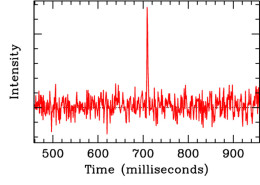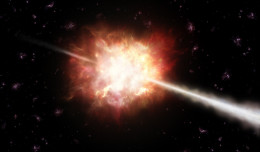Most theoretical models assume that black holes aren’t charged. But a new study shows that mergers of charged black holes could explain a variety of astrophysical phenomena, from fast radio bursts to gamma-ray bursts.
No Hair
The black hole “no hair” theorem states that all black holes can be described by just three things: their mass, their spin, and their charge. Masses and spins have been observed and measured, but we’ve never measured the charge of a black hole — and it’s widely believed that real black holes don’t actually have any charge.
That said, we’ve also never shown that black holes don’t have charge, or set any upper limits on the charge that they might have. So let’s suppose, for a moment, that it’s possible for a black hole to be charged. How might that affect what we know about the merger of two black holes? A recent theoretical study by Bing Zhang (University of Nevada, Las Vegas) examines this question.

Intensity profile of a fast radio burst, a sudden burst of radio emission that lasts only a few milliseconds. [Swinburne Astronomy Productions]
Driving Transients
Zhang’s work envisions a pair of black holes in a binary system. He argues that if just one of the black holes carries charge — possibly retained by a rotating magnetosphere — then it may be possible for the system to produce an electromagnetic signal that could accompany gravitational waves, such as a fast radio burst or a gamma-ray burst!
In Zhang’s model, the inspiral of the two black holes generates a global magnetic dipole that’s perpendicular to the plane of the binary’s orbit. The magnetic flux increases rapidly as the separation between the black holes decreases, generating an increasingly powerful magnetic wind. This wind, in turn, can give rise to a fast radio burst or a gamma-ray burst, depending on the value of the black hole’s charge.

Artist’s illustration of a short gamma-ray burst, thought to be caused by the merger of two compact objects. [ESO/A. Roquette]
Limits on Charge
Zhang’s calculations are not just useful in the hypothetical scenario where black holes are charged. They could, in fact, be a way of testing whether black holes are charged.
As we accumulate future gravitational-wave observations (and with two observations by LIGO already announced, it seems likely that there will be many more), we will grow a larger sample of follow-up observations in radio through gamma-ray wavelengths. Our detections — or our lack of detections — of fast radio bursts or gamma-ray bursts associated with these black-hole mergers will allow us to set some of the first real limits on the charge of black holes.
Citation
Bing Zhang 2016 ApJ 827 L31. doi:10.3847/2041-8205/827/2/L31

